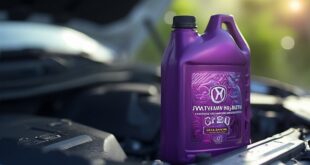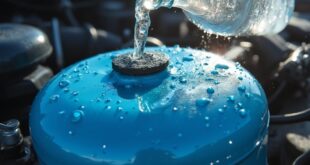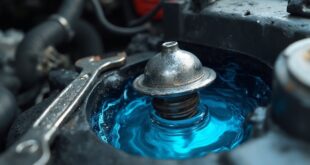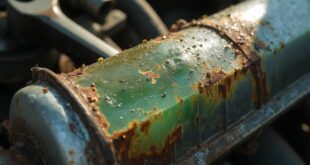If you're wondering about signs of a clogged or bad radiator, look out for a few key indicators. Your engine's temperature gauge might show overheating, and you may notice coolant leaks as puddles under your vehicle. Additionally, check for damaged radiator fins that could impede airflow. If your cabin heat is inadequate or you hear unusual noises, it's crucial to act. These symptoms could lead to bigger problems, and there's more to uncover about maintaining your radiator's health.
Overheating Engine and Temperature Readings
When your engine starts to overheat, it's crucial to pay attention to the temperature readings on your dashboard.
If the gauge approaches dangerous levels, stop driving immediately. Ignoring these signs can lead to severe engine damage.
Steam or smoke might emerge from under the hood, indicating a critical problem. Abnormal gauge readings often signal overheating coolant, so check your vehicle's cooling system.
Continuous high readings can worsen, requiring urgent intervention.
Coolant Leaks and Low Fluid Levels
Overheating can lead to serious issues, and one common culprit is coolant leaks. If you notice puddles of liquid under your vehicle or find that your coolant levels drop unexpectedly, it's time to investigate. Low fluid levels can quickly result in engine overheating, so monitoring them is essential.
Here's a quick reference to help you understand the signs:
| Signs of Coolant Leaks | Actions to Take |
|---|---|
| Puddles under the car | Check for leaks immediately |
| Low coolant levels | Refill and inspect hoses |
| Rusty or oily coolant | Replace coolant and flush system |
Stay proactive to avoid costly repairs!
Damaged Radiator Fins and Airflow Obstruction
If you've been driving on rough roads or through debris, you might notice your vehicle's cooling efficiency declining due to damaged radiator fins.
These metal fins can bend or break, obstructing airflow vital for dissipating heat. When airflow decreases, the coolant can't effectively cool your engine, leading to overheating.
You may also observe fluctuating temperature gauges as the cooling system struggles to keep up.
Regularly inspect your radiator for any visible damage, especially after off-road adventures. If you find any issues, it's important to address them promptly to maintain your vehicle's performance and prevent further complications.
Heater Malfunctions and Cabin Temperature Issues
A malfunctioning heater can leave you feeling uncomfortable during colder months, signaling potential radiator issues.
If you notice that your cabin isn't warming up as it should, it might be due to insufficient coolant flow caused by a clogged radiator. This can result in chilly air blowing from the vents, making your drive unpleasant.
Additionally, fluctuating cabin temperatures can indicate that your heating system isn't getting enough hot coolant from the radiator.
Ignoring these signs could lead to more severe radiator problems, so it's crucial to address any heater malfunctions promptly to guarantee your comfort and vehicle efficiency.
Unusual Noises and Warning Lights
While driving, you might hear unusual noises from your engine that signal potential radiator issues. If you notice clanking, hissing, or bubbling sounds, it's time to pay attention. Additionally, warning lights on your dashboard may illuminate, indicating a cooling system failure. Ignoring these signs can lead to serious problems.
| Noise Type | Possible Cause | Action Needed |
|---|---|---|
| Clanking | Loose parts or debris | Inspect engine components |
| Hissing | Steam from coolant leak | Check for leaks |
| Bubbling | Overheated coolant | Stop driving, check coolant |
| Warning Light | Overheating or coolant issue | Seek professional help |
Importance of Timely Repairs and Maintenance
Neglecting timely repairs and maintenance can lead to significant issues down the line, jeopardizing your vehicle's performance and safety.
Addressing radiator problems promptly is essential for several reasons:
- Prevent Overheating: Catching issues early helps avoid engine damage from overheating.
- Cost Savings: Timely repairs can save you money by preventing more extensive damage.
- Maintain Efficiency: A well-functioning radiator guarantees peak engine performance and fuel efficiency.
Regular checks and addressing signs of trouble can keep your vehicle running smoothly and extend its lifespan.
Don't wait—take action to protect your investment.
Frequently Asked Questions
How Can I Prevent Radiator Clogs in My Vehicle?
To prevent radiator clogs, regularly check and change your coolant, flush the system annually, and inspect hoses for damage. Keep an eye on debris and guarantee proper airflow to maintain peak performance.
What Are the Signs of a Failing Radiator Fan?
If your radiator fan's failing, you might notice inconsistent cooling, unusual noises, or the engine overheating. You should pay attention to warning lights on the dashboard, as they can signal potential issues with the fan.
Can I Use Tap Water in My Radiator?
You shouldn't use tap water in your radiator. It can lead to corrosion and mineral buildup, damaging the cooling system. Stick to a proper coolant mix for ideal engine performance and longevity.
Is It Safe to Drive With a Leaking Radiator?
Driving with a leaking radiator isn't safe. It can lead to serious overheating, engine damage, and costly repairs. You should address the leak immediately to guarantee your vehicle runs smoothly and avoids further issues.
How Often Should I Flush My Radiator System?
You should flush your radiator system every two years or as recommended in your vehicle's manual. Regular flushing helps maintain ideal coolant performance and prevents buildup that can lead to overheating and other issues.
 Car Service Land Coupons for Oil change, Tires, Wheel alignment, Brakes, Maintenance
Car Service Land Coupons for Oil change, Tires, Wheel alignment, Brakes, Maintenance




